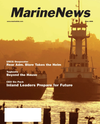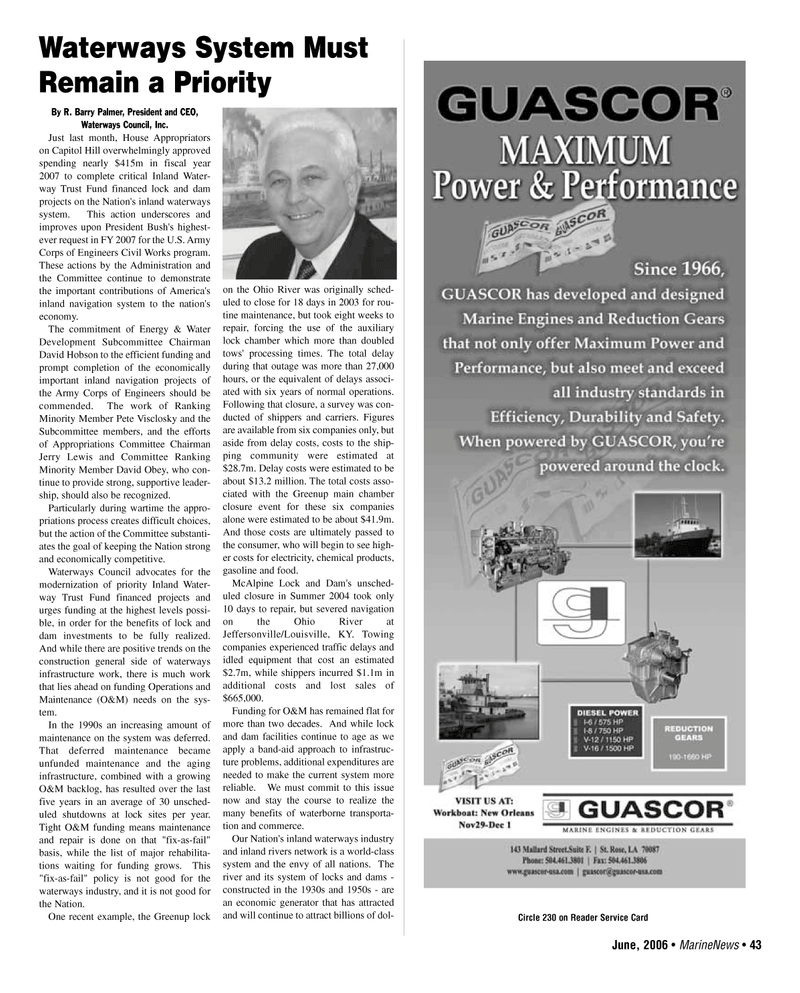
Page 43: of Marine News Magazine (June 2006)
Fourth Annual "Geo Six Pack"
Read this page in Pdf, Flash or Html5 edition of June 2006 Marine News Magazine
June, 2006 • MarineNews 43
By R. Barry Palmer, President and CEO,
Waterways Council, Inc.
Just last month, House Appropriators on Capitol Hill overwhelmingly approved spending nearly $415m in fiscal year 2007 to complete critical Inland Water- way Trust Fund financed lock and dam projects on the Nation's inland waterways system. This action underscores and improves upon President Bush's highest- ever request in FY 2007 for the U.S. Army
Corps of Engineers Civil Works program.
These actions by the Administration and the Committee continue to demonstrate the important contributions of America's inland navigation system to the nation's economy.
The commitment of Energy & Water
Development Subcommittee Chairman
David Hobson to the efficient funding and prompt completion of the economically important inland navigation projects of the Army Corps of Engineers should be commended. The work of Ranking
Minority Member Pete Visclosky and the
Subcommittee members, and the efforts of Appropriations Committee Chairman
Jerry Lewis and Committee Ranking
Minority Member David Obey, who con- tinue to provide strong, supportive leader- ship, should also be recognized.
Particularly during wartime the appro- priations process creates difficult choices, but the action of the Committee substanti- ates the goal of keeping the Nation strong and economically competitive.
Waterways Council advocates for the modernization of priority Inland Water- way Trust Fund financed projects and urges funding at the highest levels possi- ble, in order for the benefits of lock and dam investments to be fully realized.
And while there are positive trends on the construction general side of waterways infrastructure work, there is much work that lies ahead on funding Operations and
Maintenance (O&M) needs on the sys- tem.
In the 1990s an increasing amount of maintenance on the system was deferred.
That deferred maintenance became unfunded maintenance and the aging infrastructure, combined with a growing
O&M backlog, has resulted over the last five years in an average of 30 unsched- uled shutdowns at lock sites per year.
Tight O&M funding means maintenance and repair is done on that "fix-as-fail" basis, while the list of major rehabilita- tions waiting for funding grows. This "fix-as-fail" policy is not good for the waterways industry, and it is not good for the Nation.
One recent example, the Greenup lock on the Ohio River was originally sched- uled to close for 18 days in 2003 for rou- tine maintenance, but took eight weeks to repair, forcing the use of the auxiliary lock chamber which more than doubled tows' processing times. The total delay during that outage was more than 27,000 hours, or the equivalent of delays associ- ated with six years of normal operations.
Following that closure, a survey was con- ducted of shippers and carriers. Figures are available from six companies only, but aside from delay costs, costs to the ship- ping community were estimated at $28.7m. Delay costs were estimated to be about $13.2 million. The total costs asso- ciated with the Greenup main chamber closure event for these six companies alone were estimated to be about $41.9m.
And those costs are ultimately passed to the consumer, who will begin to see high- er costs for electricity, chemical products, gasoline and food.
McAlpine Lock and Dam's unsched- uled closure in Summer 2004 took only 10 days to repair, but severed navigation on the Ohio River at
Jeffersonville/Louisville, KY. Towing companies experienced traffic delays and idled equipment that cost an estimated $2.7m, while shippers incurred $1.1m in additional costs and lost sales of $665,000.
Funding for O&M has remained flat for more than two decades. And while lock and dam facilities continue to age as we apply a band-aid approach to infrastruc- ture problems, additional expenditures are needed to make the current system more reliable. We must commit to this issue now and stay the course to realize the many benefits of waterborne transporta- tion and commerce.
Our Nation's inland waterways industry and inland rivers network is a world-class system and the envy of all nations. The river and its system of locks and dams - constructed in the 1930s and 1950s - are an economic generator that has attracted and will continue to attract billions of dol-
Circle 230 on Reader Service Card
Waterways System Must
Remain a Priority
JUNE MN2006 6(41-48).qxd 6/2/2006 4:20 PM Page 43

 42
42

 44
44
